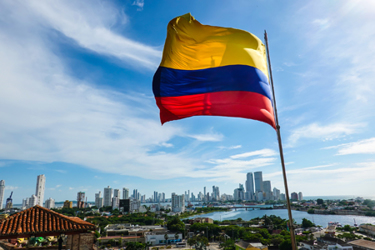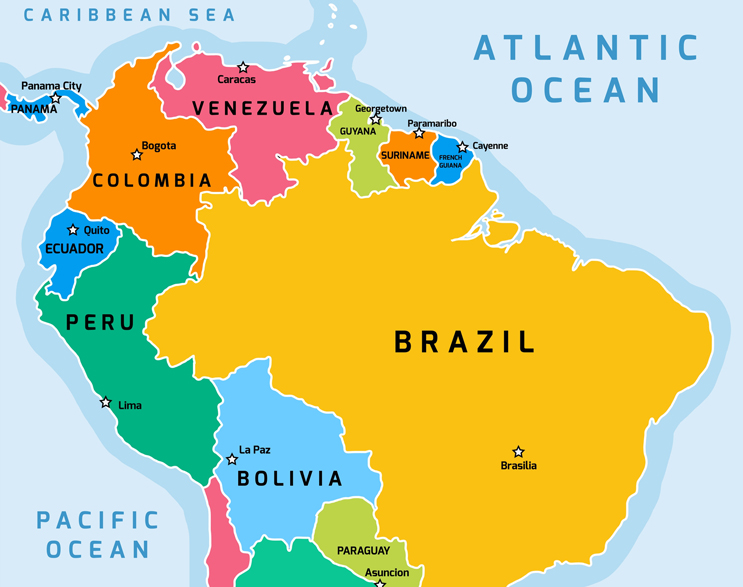The Large Market For Medical Devices In Colombia May Surprise You
By Julio G. Martinez-Clark, CEO, bioaccess

Colombia has a population of approximately 50 million inhabitants, making it the third most populous country in Latin America after Mexico and Brazil.1 Colombia's economy is the fourth-largest by volume in Latin America, after Brazil, Mexico, and Argentina.2 Together, Brazil, Mexico, Colombia, Chile, and Argentina could represent the fourth-largest economy globally, with health spending equivalent to India or China. Colombia, along with Mexico, Costa Rica, and Chile, is one of the only countries in the region that is a member of the Organization for Economic Cooperation and Development (OECD). The OECD membership grants Colombia access to the best economic and social practices, along with the U.S., Canada, and other advanced economies that are members. Colombia stands out in Latin America for its solid institutions and its commitment to the private sector, which has made it one of the most economically and politically stable markets in Latin America.3
This article discusses why Colombia, despite the global effects of the COVID-19 pandemic, has become the country with the best commercial advantages in South America and one of the three best in Latin America for foreign medical device manufacturers to market their innovations. We will cover the general Colombian health social security system (coverage, affiliation, and forms of financing); the current medical device regulatory framework, including the short marketing authorization times compared to other countries in the area, and the size and trends of the market.

Colombia’s Healthcare System
The Colombian health system comprises two coexisting systems: the contributory regime (private) and the subsidized regime (gratuitous). Private employees and employers finance the private health regime out of their paychecks (approximately 12 percent of their income). The Colombian state entirely funds the subsidized regime. A social program called SISBEN allows the population to be classified according to their income and living conditions and defines who can access the subsidized health system.4 Both coexisting systems provide universal coverage with equal access to medicines, surgical procedures, and medical/dental services.
Colombia’s public spending on health has increased almost three times from 2017 to 2020, from $3.2 billion to $9 billion, even though less than half of the population able to work do not have a formal job that allows them to contribute to the health system.5
Health is a fundamental right enshrined in the national constitution. The Colombian state subsidizes the health needs of the poor and vulnerable population so they can exercise their fundamental right to health.6 Public and private operators (hospitals and clinics known as Service Provider Institutions [IPS in Spanish]) provide health services. Insurance companies (known as Health Promotion Institutions [EPS in Spanish]) manage private or public health benefit plans and contract with IPS to provide health services.
Despite financial difficulties from the pandemic, the Colombian state has continued to guarantee all health services to Colombians, including those derived from COVID-19. It has increased the capacity of hospitals by 3 percent.7 The national government even decreed a temporary economic relief package for healthcare professionals.8 According to a 2021 report, in terms of hospital quality, Colombia has about 50 percent out of the best-ranked hospitals in South America.9
Colombia is the only country in Latin America with a good clinical practices (GCP) certification system at the institutional level (on top of the GCP requirement for each investigator, study coordinator, and staff). Colombia has about 130 GCP-certified clinical research centers (the majority in level 4 hospitals). It has one of the fastest and most predictable regulatory timelines for medical device clinical trials in Latin America. Colombia’s unique GCP hospital-level certification system supports the quality and dynamism of the local biomedical research industry. It ensures that the clinical data that foreign medical device companies get from research centers in Colombia is of the utmost quality.10 The U.S. medtech industry already recognizes Colombia as one of the best destinations for early-stage or first-in-human (FIH) clinical studies with innovative medical technologies. Established companies like Cook Medical, PAVmed Inc. (Nasdaq: PAVM, PAVMZ), enVVeno Medical Corporation (Nasdaq: NVNO), and startup companies like ReGelTec, Inc., NeoProgen, Inc., and Sonnest, Inc. are conducting FIH clinical trials in Colombia. These medtech companies are taking advantage of Colombia’s predictable and fast regulatory approval timelines, speedier patient recruitment, short flights from any major U.S. city, familiar EST time zone, and lower clinical research costs.
Colombia’s Medical Device Regulatory Framework
The Ministry of Health and Social Protection (MinSalud) issues laws and regulates the health system. The National Food and Drug Surveillance Institute (INVIMA), among its functions, authorizes marketing, certifies imports, and performs post-marketing surveillance. INVIMA, like the European Union, uses a risk-based classification system and classifies medical devices in Colombia into four classes: I (low risk), IIA (moderate risk), IIB (high risk), and III (very high risk).11
The decrees that regulate medical devices in the country are:
- Decree 3770/2004 (Sanitary Registry of Diagnostic Reagents)12
- Decree 4725/2005 (Sanitary Registry of Sanitary Products)13
- Decree 1011/2006 (Guarantee of Quality of Medical of Health)14
- Resolution 4815/2008 (National Technovigilance Program)15
- Decrees 581 and 582/2017 (Simplification of procedures for Medical Devices and In Vitro Diagnostic Reagents)16
- Decree 3275 of 2009 (Modification of Decree 4725/2005)17
Obtaining market clearance for a medical device at INVIMA is fast and predictable. INVIMA requires notification for low-risk class I and IIA devices. Additionally, it requires a certificate of free sale in the country of origin or a reference country (U.S., Canada, the European Union, Japan, and Australia). For class IIB and III devices, INVIMA issues an administrative act after a legal and technical review of the application. Decree 3275 of 2009's provision homologates the following documents for class IIB medical devices: technical studies and analytical verifications, sterilization methods, disposal methods or final disposals, and clinical studies.
In Colombia, the regulatory approval time to obtain market clearance for a medical device ranges from 15 to 90 days. In other countries in the region, such as Argentina, it is approximately 200 days, and in Brazil, about 360 days.18 The validity of an INVIMA sanitary registration is 10 years, allowing foreign manufacturers to be the title holders of the registration certificate (as opposed to in other countries, where they must use the services of a third-party registration holder). The fact that Colombia allows foreign entities to hold the title of the INVIMA registration certificate enables foreign companies to fully control any amendments to the registration and add or remove distributors.19
The Colombian government has an online public procurement mechanism called Colombia Compra Eficiente.20 The best approach is for foreign manufacturers to partner with local distributors experienced in selling through public bids for the construction and equipping of hospitals and clinics.21
Trends & Market Outlook
The makeup of the medical device market in Colombia is the following:
- Consumable products (30%),
- Diagnostic imaging (13%),
- Orthopedic and prosthetic products (16%),
- Patient aids (12%),
- Dental products (5%), and
- Other types of medical devices (24%).
The Colombian medical device market, the third largest in Latin America after Brazil and Mexico, has an estimated average annual growth rate between 2020 and 2024 of 5.3 percent, and will likely reach about $1.6 billion in 2023. Colombia has a strong reliance on imports, and these represent over 80 percent of the total sales. This is one of the reasons that bring up great opportunities for local production, to gain competitiveness diminish the effect of wide currency exchange rate fluctuations against the US dollar.18
The United States is the leading importer of medical devices in Colombia. The European Union, Asia, and Oceania constitute large medical device supply markets for Colombia. Although some multinational companies manufacture medical devices in Colombia, the most imported items are:
- Diagnostic reagents (15%),
- Surgical instruments (12%),
- Catheters (9%),
- Electro-medical devices (4%), and
- Other products (60%).22
Colombia's capital city, Bogota, is the center of the medical device industry in Colombia and represents over 75% of the sales in the country.18 A free zone has encouraged international companies to manufacture locally and enter the market within the capital. In its most recent evaluation, called American Cities of the Future 2021-2022, the Financial Times magazine fDi cataloged the Colombian capital as the second most important city in Latin America for foreign direct investments, surpassed only by Mexico City.14
Conclusion
Colombia is now poised to become the fastest-growing economy in Latin America. In 2021, the Colombian economy grew the most in 115 years. Bloomberg analysts predict that the Colombian economy will grow 4% this year, outpacing Brazil, Mexico, Peru, and Chile.23 Colombia is an attractive market for medical device makers because the health system dynamics have allowed universal coverage in the provision of health services (including surgical procedures and other expensive interventions). In addition, there is lavish spending on health personnel, hospital infrastructure, medical services, equipment, and consumables. Colombia has the fastest regulatory approval times in Latin America. It has free trade agreements with the United States and the European Union, facilitating the rapid importation of medical devices. Colombia is now the third largest medical device market in the region and needs to import the great majority of the medical devices it needs. A challenge, however, is that although health coverage is increasingly universal (approximately 95% of the population) with the expansion and updating of the health benefit plan, it is still insufficient to meet the needs of 76% of the Colombian people, which includes the recent incorporation of Venezuelan immigrants into the health system.24 It is strongly recommended that U.S. companies process the registration under their name and not under the local distributor name, or else the U.S. company will not be able to change or add distributors during the lifetime of the registration, which is 10 years.25
References
- Banco Mundial. Datos. Población, total - Latin America & Caribbean. Published 2021. Accessed October 29, 2021. https://datos.bancomundial.org/indicator/SP.POP.TOTL?locations=ZJ&most_recent_value_desc=true
- International Monetary Fund. "GDP per capita, current prices, U.S. dollars per capita". World Economic Outlook Database, 2021. https://www.imf.org/external/datamapper/NGDPDPC@WEO/OEMDC/ADVEC/WEOWORLD
- Organisation for Economic Cooperation and Development (OECD). Colombia. Accessed March 2, 2022. https://www.oecd.org/colombia/
- Departamento nacional de planeación. Sisbén. Published 2020. Accessed December 1, 2020. https://www.sisben.gov.co/atencion-al-ciudadano/paginas/consulta-del-puntaje.aspx
- Ramírez Ramírez A, Rocha Beltrán D, Durango Suárez LF, Rodríguez Álvarez SB. Implicaciones de la ley estatutaria 1751 de 2015 sobre las entidades promotoras de salud del régimen contributivo. Rev CES Derecho. 2016;7(2):13-41. https://www.scielo.org.co/pdf/cesd/v7n2/v7n2a03.pdf
- Colombia M de salud de. Aseguramiento Al Sistema General de Seguridad Social En Salud.; 2014. https://www.minsalud.gov.co/sites/rid/Lists/BibliotecaDigital/RIDE/VP/DOA/RL/cartillas-de-aseguramiento-al-sistema-general-de-seguridad-social-en-salud.pdf
- Oficina de Coordinación de Asuntos Humanitarios de las Naciones Unidas. PLAN DE RESPUESTA COVID-19 COLOMBIA.; 2020. https://www.who.int/health-cluster/countries/colombia/Colombia-COVID-19-response-plan.pdf?ua=1
- Ministerio de salud y protección social. Resolución 185 de 2021.; 2021. https://www.minsalud.gov.co/Normatividad_Nuevo/Resolución No. 185 de 2021.pdf
- America Economia. Ranking de los Mejores Hospitales 2021. 2021. https://www.americaeconomia.com/negocios-industrias/ranking-de-los-mejores-hospitales-2021-el-futuro-que-la-pandemia-nos-esta
- Invima. Instituciones Certificadas En Buenas Prácticas Clínicas a Febrero de 2018.; 2018. https://paginaweb.invima.gov.co/images/pdf/inspecion_y_vigilancia/buenas-practicas-clinicas/listado-documentos/29-3-19/BPC_1_IPS_Certificadas_Marzo_2019.pdf
- Instituto Nacional de Vigilancia de Medicamentos y Alimentos (Invima). Dispositivos médicos y equipos biomédicos. Accessed December 20, 2021. https://www.invima.gov.co/dispositivos-medicos-y-equipos-biomedicos
- Ministerio de protección social. Decreto 3770 de 2004.; 2004. https://www.minsalud.gov.co/Normatividad_Nuevo/DECRETO 3770 DE 2004.PDF
- Ministerio de la protección social. Decreto Número 4725 de 2005.; 2005. https://www.who.int/medical_devices/survey_resources/health_technology_national_policy_
colombia.pdf - MINISTERIO DE LA PROTECCIÓN SOCIAL. Resolución Número 1043 De 2006. Minist La Protección Soc . 2006;2006:1-5.
- Ministerio de la Protección Social. Resolución 4815/2008.; 2008. https://www.saludcapital.gov.co/DSP/Tecnovigilancia/Resolución 4816 de 2008.pdf
- Ministerio de salud y protección social. Decreto 581 de 2017.; 2017. https://es.presidencia.gov.co/normativa/normativa/DECRETO 581 DEL 04 DE ABRIL DE 2017.pdf
- Presidencia de la República de Colombia. Decreto 3275 de 2009.; 2009:1. https://www.alcaldiabogota.gov.co/sisjur/normas/Norma1.jsp?i=37226
- Medical Devices. Invest in Bogota; 2021. https://en.investinbogota.org/investment-sectors/medical-devices
- Presidencia de la República de Colombia. DECRETO NÚMERO 677 DE 1995.; 1995:72. https://www.invima.gov.co/documents/20143/453029/decreto_677_1995.pdf
- Agencia Nacional de Contratación Pública - Colombia Compra Eficiente. COLOMBIA COMPRA EFICIENTE. Published 2021. https://colombiacompra.gov.co/secop/colombia-compra-eficiente
- Dirección de Prestación de Servicios y Atención primaria. Asociaciones Público Privadas En El Sector Salud.; 2018. https://www.minsalud.gov.co/sites/rid/Lists/BibliotecaDigital/RIDE/VS/PSA/Asociaciones-publico-privadas-salud.pdf
- Sánchez González M. Chamber of Medical Devices and Health Supplies. In: ; 2021.
- ALJAZEERA, Bloomberg. Record expansion: Colombia's economy grows the most in 115 years. February 15, 2022. https://www.aljazeera.com/economy/2022/2/15/record-expansion-colombias-economy-grows-the-most-in-115-years
- Bejarano-Daza JE, Hernández-Losada DF. Fallas del mercado de salud colombiano. Rev la Fac Med. 2017;65(1):107-113. doi:10.15446/revfacmed.v65n1.57454.
- U.S. International Trade Administration. Colombia-Country Commercial Guide-Medical Equipment. 2021. https://www.trade.gov/knowledge-product/colombia-medical-equipment
About The Author:
 Julio G. Martinez-Clark is co-founder and CEO of bioaccess, a market access consultancy that works with medical device companies to help them do early-feasibility clinical trials and commercialize their innovations in Latin America. Julio is also the host of the LATAM Medtech Leaders podcast: A weekly conversation with Medtech leaders who have succeeded in Latin America. He serves as an advisory board member for Stetson University's Leading Disruptive Innovation program. He has a bachelor's degree in electronics engineering and a master's degree in business administration.
Julio G. Martinez-Clark is co-founder and CEO of bioaccess, a market access consultancy that works with medical device companies to help them do early-feasibility clinical trials and commercialize their innovations in Latin America. Julio is also the host of the LATAM Medtech Leaders podcast: A weekly conversation with Medtech leaders who have succeeded in Latin America. He serves as an advisory board member for Stetson University's Leading Disruptive Innovation program. He has a bachelor's degree in electronics engineering and a master's degree in business administration.
